Episode 134: STS-60 - A New Partnership (WSF, SPACEHAB, Shuttle-Mir)
Table of Contents
Look out! There’s a Russian on the space shuttle! Oh, we invited him? Well alright then. On STS-60 we’re going to push some atoms out of the way, begin the partnership that would lead to the ISS, and wonder what it takes to get a Coke in Russia.
Episode Audio #
Photos #
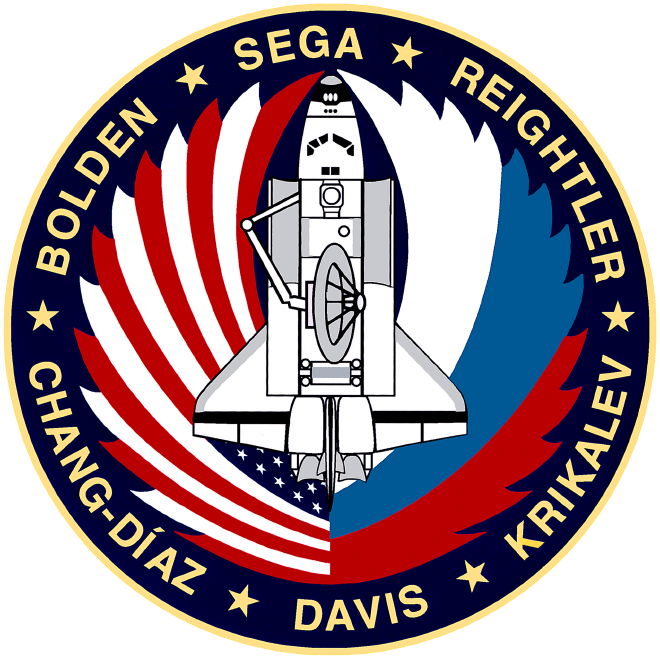
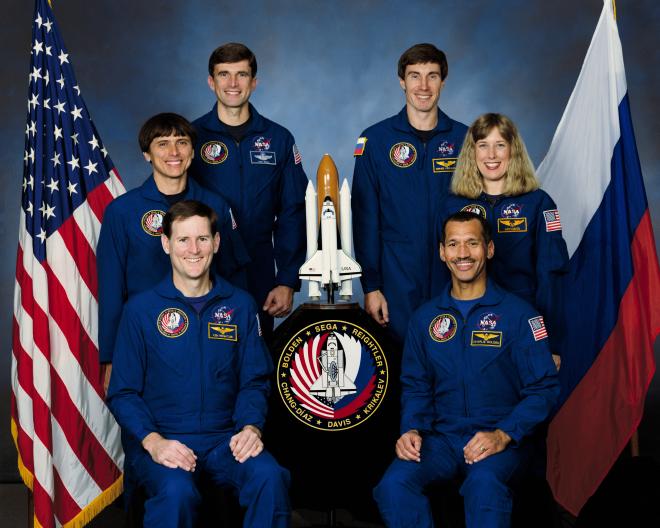
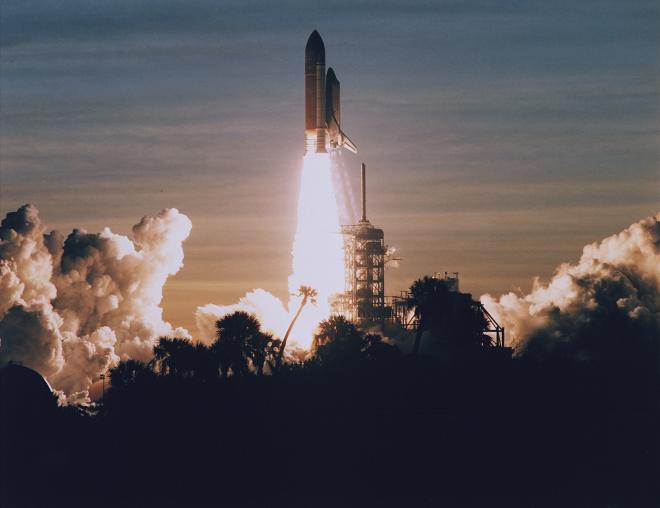
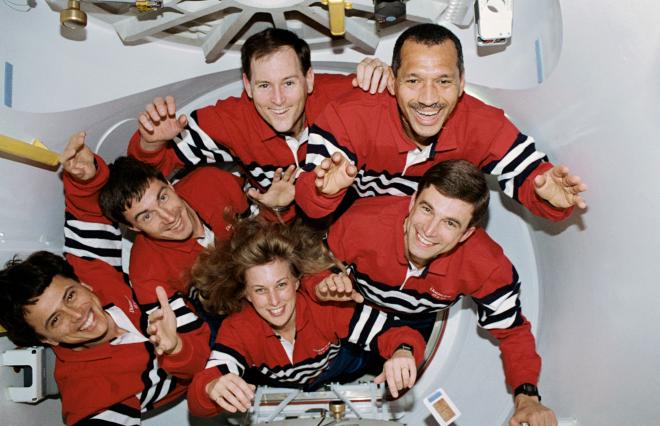
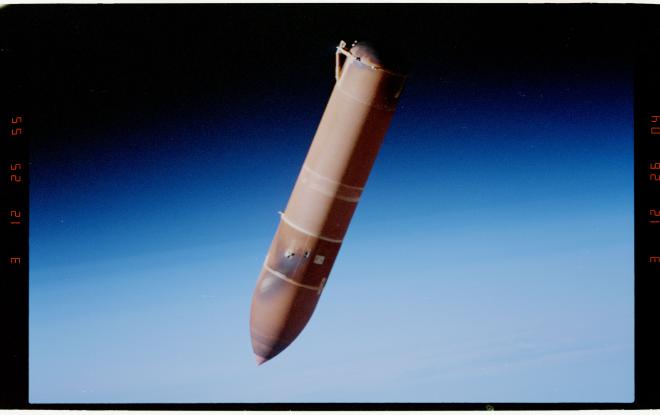
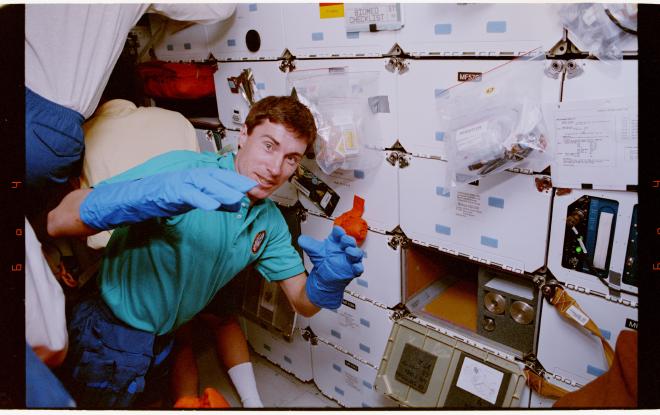
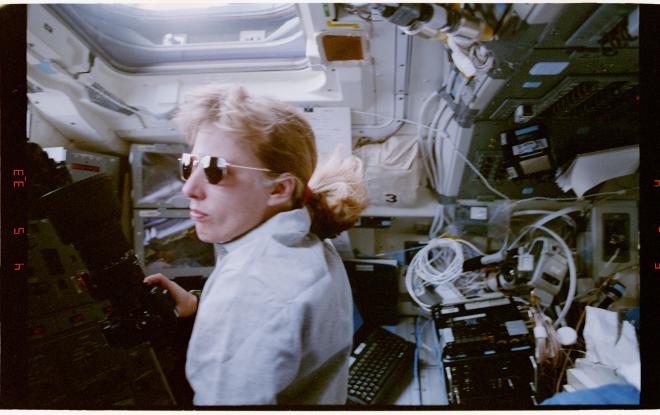
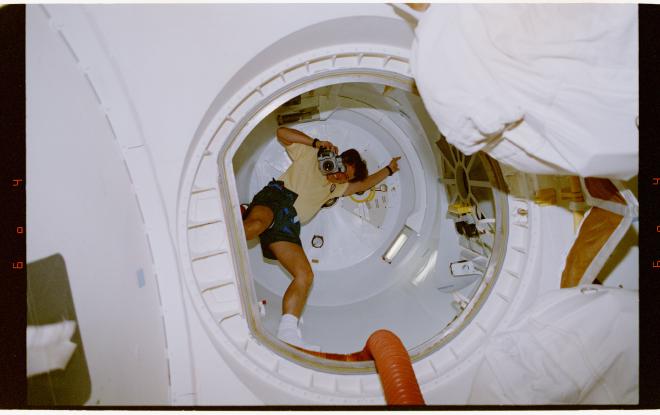
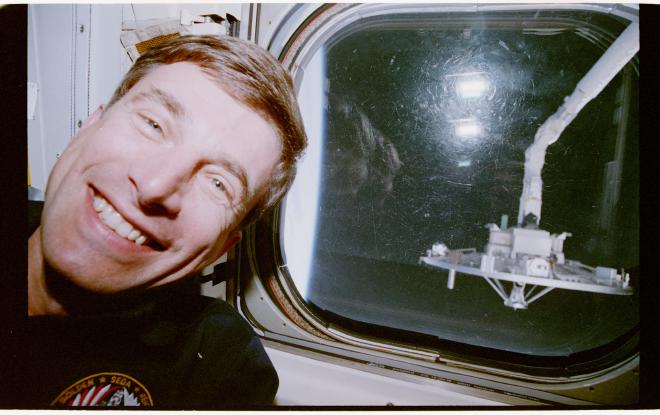
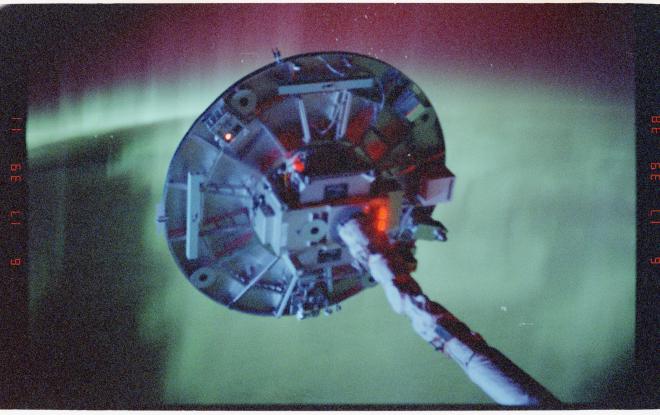
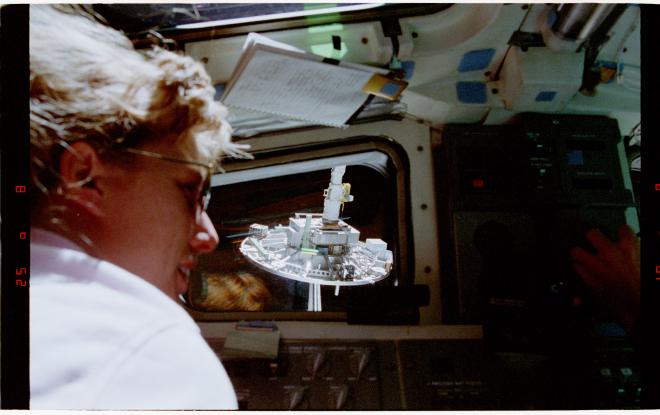
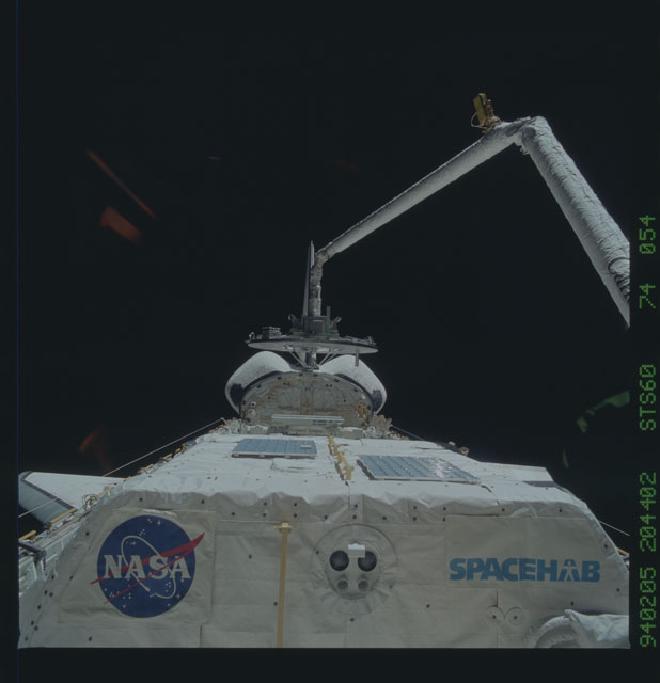
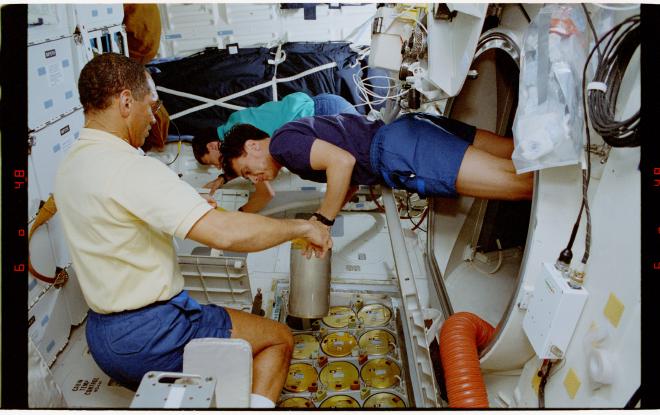
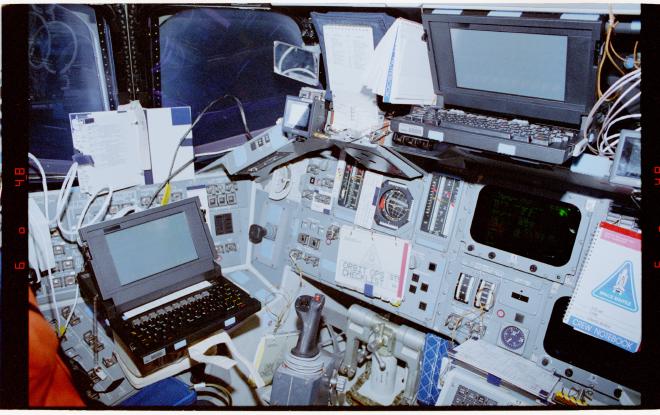
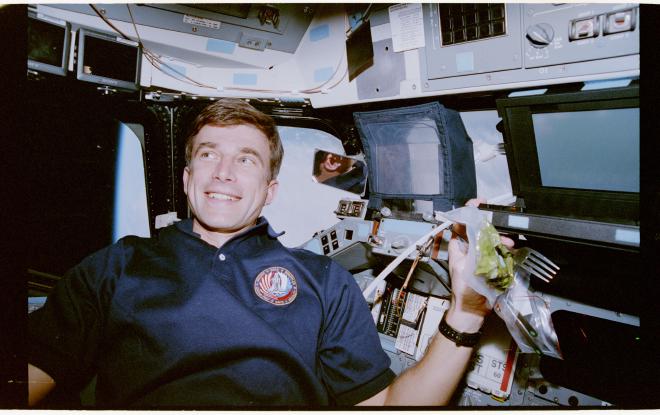
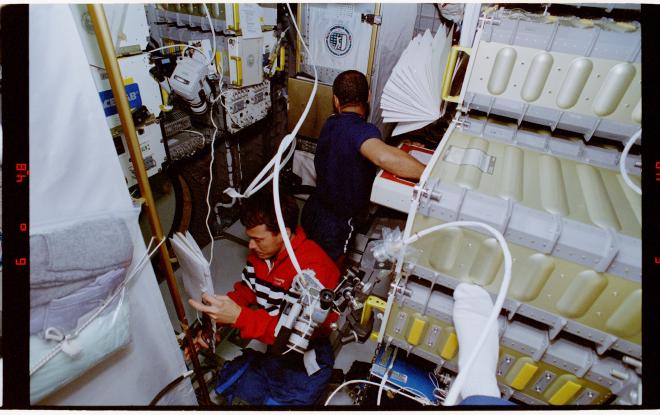
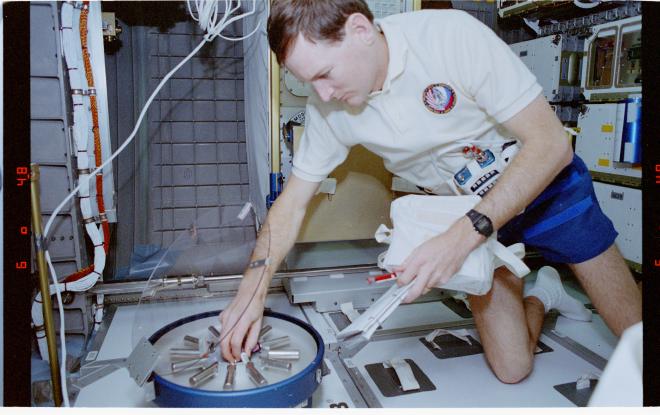
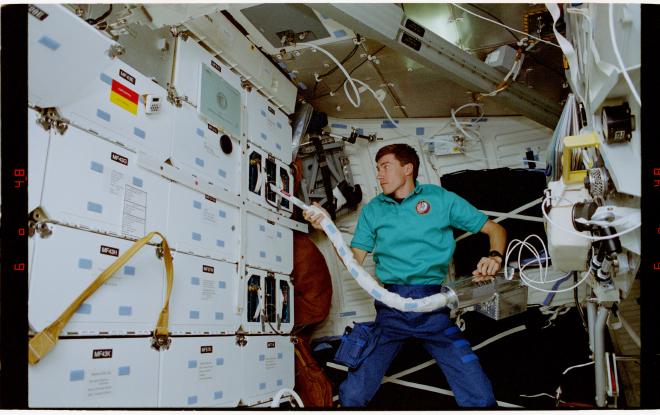
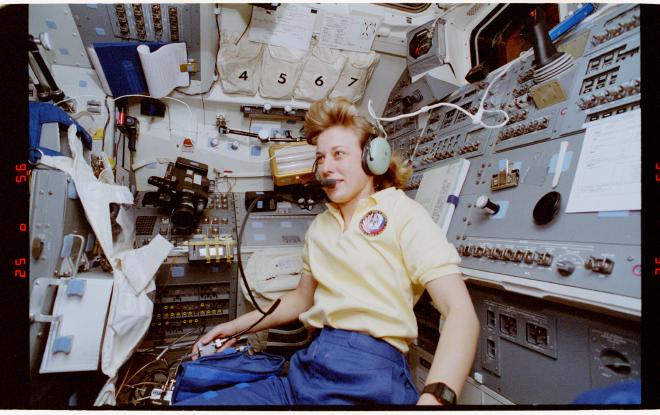
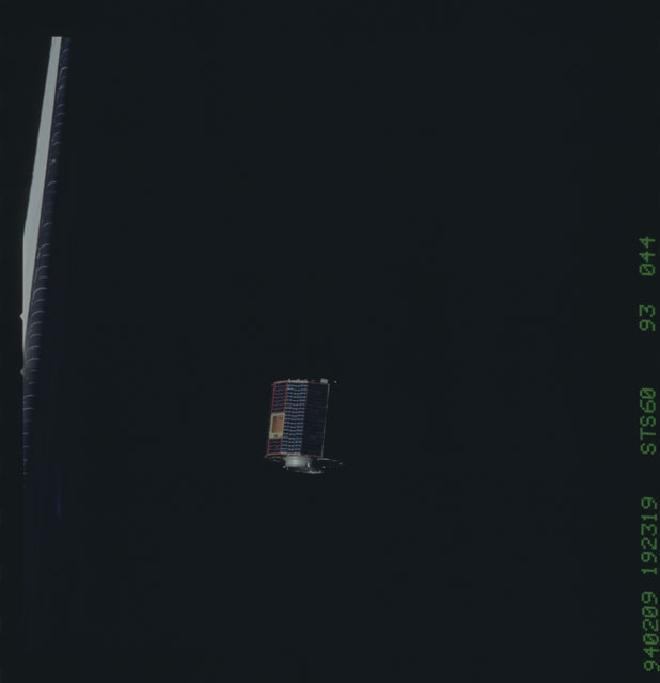
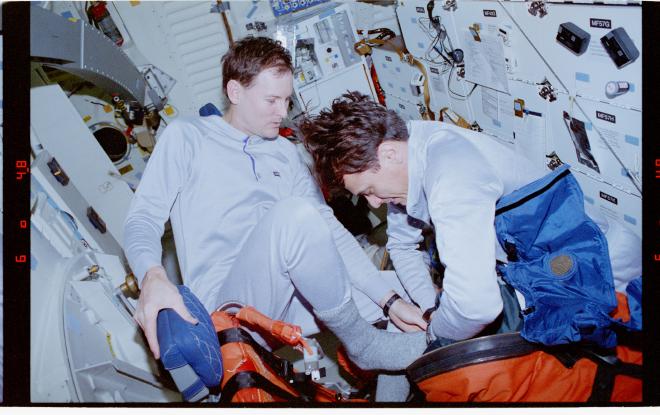
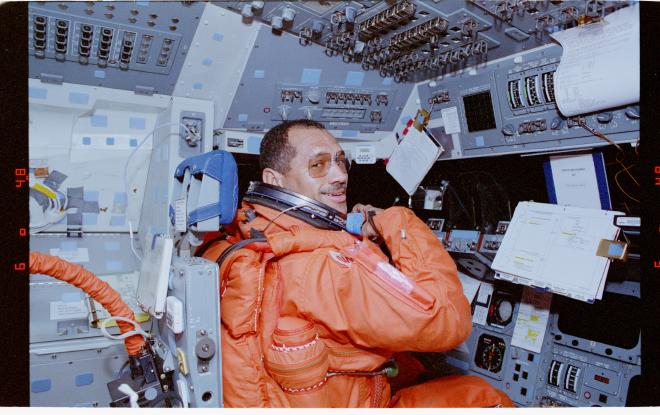
Post-Flight Presentation #
If you’d like to see the mission in motion you can check out the post-flight presentation here:
Transcript #
NOTE: This transcript was made by me just copying and pasting the script that I read to make the podcast. I often tweak the phrasing on the fly and then forget to update the script, so this is not guaranteed to align perfectly with the episode audio, but it should be pretty close. Also, since these are really only intended to be read by myself, I might use some funky punctuation to help remind myself how I want a sentence to flow, so don’t look to these as a grammar reference. If you notice any egregious transcription errors or notes to myself that I neglected to remove, feel free to let me know and I’ll fix it.
Hello, and welcome to The Space Above Us. Episode 134, Space Shuttle flight 60, STS-60: A New Partnership
Last time, we talked about the first servicing mission to the Hubble Space Telescope: STS-61. Over the course of the most intense work week in history, we packed in five EVAs with dozens of hours logged outside the spacecraft. Correcting Hubble’s flawed mirror, replacing jittery solar arrays, and making various other upgrades to the orbiting observatory was a pivotal moment in the history of the space shuttle. The decades-long vision of a reusable spacecraft carrying a crew to a satellite and performing regular, planned (and a little unplanned) maintenance, had finally become reality. So not only did we rescue one of science’s greatest assets, we also showed that NASA could take the next step in EVA complexity, and even bigger projects were possible.
In the previous two episodes, we focused on the negative outcomes that can result from features on the micrometer and even nanometer scale. But not everything at that scale is problematic. At this point in history, the early 1990s, another technology found the word “nanometer” becoming more and more common: the manufacturing of integrated circuits.
I don’t think I’m breaking any news here when I say that the world runs on integrated circuits. There are dozens of them in your phone, in your watch, in your car, and most notably, in your computer.
For this next section, I think I’m in the clear, but in my usual overly-cautious way I’d like to point out that since this is a spaceflight podcast and not an electronics podcast, I’m just writing this off the top of my head and didn’t do any proper research. So take it with a grain of salt. Or silicon. Anyway. Integrated circuits are just what they sound like. It didn’t take long after the invention of electronics for people to notice that certain circuits came up again and again. Rather than build it from scratch every time, what if they integrated these circuits together ahead of time and put them in one easy to use form factor. So if you needed a timer, instead of a bunch of transistors and wires and stuff, you’d just have one little black chip with a few metal pins on it. Once these chips started housing increasingly powerful general purpose CPUs, the next step was to try to fit more things into these integrated circuits, so you could make the overall device smaller or more capable. Eventually, the circuits became so small and so many were needed that using normal wires didn’t really make sense anymore, so people started using lithography, using light to form tiny conductive circuits.
For this process, you can just imagine someone using a stencil and spray paint, but sort of in reverse. You start with a layer of conductive material, put a stencil in front of it, and use some special light and some special chemicals to melt away the exposed parts. If you made your stencil look like a bunch of wires arranged to make a circuit, congratulations, now you have a circuit.
Traditionally this has been done with silicon, since it’s super abundant, and easy to get to the required purity level to make itty bitty circuitry. But as the silicon circuits got smaller and smaller, more problems arose due to various reasons that are too in the weeds to get into. A possible solution was to use a material with some more favorable characteristics called Gallium Arsenide. It might sound familiar since we’ve actually had a number of payloads dedicated to this material already. The reason gallium arsenide wasn’t already being used in circuits and the reason it was flying on the shuttle were one in the same: it had too many impurities. These impurities made it impossible to make super small circuits. But theoretically, if the gallium arsenide could be properly purified, researchers believed that it would perform much better than silicon. So these experiments were trying to take advantage of the weightless environment to grow really pure crystals of gallium arsenide.
If I understand correctly, this was actually working reasonably well, but what you really need in order to make integrated circuits, is a thin film of this stuff, not a big ol’ crystal. So how do we make that happen? Epitaxy. No, Dungeons & Dragons players, not Tabaxi. Epitaxy.
With epitaxy, a material is built up layer by layer at the atomic scale. I’m no expert in this, but to reuse an earlier example, I sort of imagine it like spray paint. By using some clever physics, it was possible to control a stream of individual molecules and just place them on a surface, building up a crystal layer by layer. If you could do this, then you could control the structure, and get exactly what you wanted. I’m pretty sure there’s more to it than just this, especially involving the crystalline structure, but that’s the gist of it. But can you see the problem with building up a material layer by layer at the atomic scale? How do you guarantee that only the atoms and molecules you want get added to the layer?
Well, you get rid of them! If there are no other molecules then there’s nothing to interfere. OK great, so we just head down to the local vacuum chamber and get to work, right? Not quite. It turns out that even though we call it a vacuum, there can still be a fair amount of molecules bouncing around, just looking for a nice surface to bond to. What we need, is a vacuum with virtually no molecules at all. I think you see where this is going.. let’s build these thin films in space! Space is a vacuum and it turns out that we fly to it pretty regularly these days. But, as we’ve learned time and time again, low earth orbit actually has a fair amount of atmosphere still bouncing around. So while it’s a pretty good vacuum, it’s still not good enough. What we need is.. an ultra vacuum.
And this is where the primary payload for today’s mission comes in: the Wake Shield Facility, or WSF. The three-and-a-half meter wide disc of stainless steel that we call the Wake Shield Facility is basically an umbrella for low earth orbit. But instead of protecting a person from rain, we’re going to protect our epitaxy experiment from atomic oxygen. I’m gonna go ahead and say don’t actually try this at home, but imagine driving down the highway in the rain, while someone holds an umbrella out the window, pointed in the direction of travel. The umbrella is going to push the rain in front of it out of the way, and if you’re going fast enough, the rain falling down from above it won’t have a chance to get to the bottom. So you would end up with this cone of dryness, protected from the rain. This is exactly what we’re doing to do with the Wake Shield Facility.
By turning the flat disc that is the WSF into the direction of travel, the few pesky atoms that would normally be encountered in low earth orbit get pushed out of the way, leaving a cone behind the disc that’s almost completely empty. A cone of ultra vacuum. On this side, the thin film gallium arsenide experiments could proceed completely undisturbed.
Now, you may have noticed another problem here. This thing can block the tenuous atmosphere in low earth orbit, but what about contamination from the shuttle? As we’ve learned, the shuttle is a big noisy vehicle. It’s outgassing, it’s dumping water overboard, it’s firing thrusters.. it’s emitting small clouds of all sorts of stuff. Ah, fear not, because the Wake Shield Facility was one of these nifty little free flying payloads. It has its own attitude control system, onboard electronics, and radio link back to the shuttle. We’re going to release it and then drop back about 75 kilometers so it can work without worrying about orbiter contamination. Pretty cool!
So who will get to carry this big flat metal space-umbrella to orbit? Let’s find out.
Commanding this flight was our old buddy Charlie Bolden. Charlie Bolden has been with us since STS-61C, though we most recently saw him flying as commander on STS-45, the ATLAS-1 mission. And while Bolden’s role didn’t really focus on the science payloads in the back of the orbiter, I would be remiss if I didn’t use every mention of STS-45 to remind you that they fired crazy electron beams at the earth, making artificial aurora. This flight marks Bolden’s fourth and final mission, but don’t worry, we’ll see him again in another capacity a little down the road. If you just can’t wait though, depending on when you listen to this, you can always enjoy his introduction to the Space Shuttle mission simulator ride at the Kennedy Space Center Visitor Complex.
Joining Bolden up front was another spaceflight vet, Ken Reightler. We last saw Reightler on his first flight, also piloting Space Shuttle Discovery, but that time on STS-48, which deployed the UARS environmental satellite. Like Bolden, this is also Reightler’s final flight, but as far as I know, you can’t see him introducing any theme park rides.
Behind Reightler we find Mission Specialist 1, Jan Davis. We know Davis from her flight on STS-47, which is also known as Spacelab-J. I guess for this flight, Davis will be trading in Japanese for Russian. I wonder which one she would say is harder. In any case, this is her second of three flights.
Next to Davis was Mission Specialist 2, Ron Sega. Ronald Sega was born on December 4th, 1952, in Cleveland, Ohio. He earned a bachelor’s in Math and Physics from the US Air Force Academy, followed shortly by a master’s in Physics from Ohio State. Later he also picked up a doctorate in Electrical Engineering from the University of Colorado. With the Air Force, he learned how to fly, becoming an instructor pilot. He then returned to the Air Force Academy’s Physics department to construct a lab designed to investigate microwave fields. He’ll continue to put his physics and engineering background to use as an astronaut, since he was one of the two principal investigators for the Wake Shield Facility. NASA selected him as an astronaut in 1990, and this is his first of two flights.
Moving downstairs, Mission Specialist 3 is someone who is very familiar to us at this point, Franklin Chang-Diaz. This is the fourth time we’ve flown with Chang-Diaz, with his most recent flight being on STS-46, deploying EURECA and sort of deploying the Tethered Satellite System. Chang-Diaz clearly has not had enough of space though, since we’ll be seeing him on three more missions in the years to come.
And lastly, Mission Specialist 4, who is someone who requires a little explanation. For the first time on this show, we are introducing a crew member who has already spent time on orbit before joining our stage. But how can that be? I always include a brief biography for everybody’s first flight. Is it possible that I missed a flight? No, it’s just that these flights didn’t meet the criteria for the show.. So now flying for the third time, let’s meet the veteran of Soyuz TM-7, Soyuz TM-12, and two lengthy stays on the space station Mir: Sergei Krikalev. A Russian. I’ll explain later.
Sergei Krikalev was born on August 27th, 1958 in Leningrad, Russia, which is now St. Petersburg. He earned a degree in mechanical engineering from what was then called the Leningrad Mechanical Institute, before joining NPO Energia, which was sort of the Soviet space program, but it turns out that’s kind a complicated topic. When he wasn’t testing space equipment and developing ops for orbiting crews, he was flying as part of the national aerobatic flying teams, winning multiple awards. In 1985 he was selected as a Cosmonaut and began training to fly on Buran, the Soviet response to our Space Shuttle. In 1988 and 1991, Krikalev flew to Mir completing two long duration flights and racking up over a year in space. In fact, he was up there for so long that he launched as a citizen of the Soviet Union.. and landed as a citizen of Russia! His flight had outlived the country that send him there.
Fun fact, remember how on STS-45, Charlie Bolden and the rest of the crew briefly spoke with the crew of Mir? It turns out that Krikalev was one of the Mir crew members he spoke to!
Sergei Krikalev may have trained to fly on a different white and black spaceplane, but instead, he will now become the first Russian to launch on an American spacecraft. We’ll talk more about how in just a little bit.
The launch was postponed a few times during long term planning, but when launch day finally arrived, Space Shuttle Discovery encountered no delays or scrubs, lifting off on February 3rd, 1994 at 7:10 AM and soaring into a 350 kilometer high orbit with a 57 degree inclination. And actually, on that topic, I’m not sure why this mission had such a high inclination, so if anyone knows, please shoot me a message, jp@thespaceabove.us.
OK, before we really get started with the mission, I suppose I should explain what this Russian guy is doing here. First of all, I’m just gonna be blunt with you on this.. I’m not going to be getting super in depth into how the American and Russian space partnership came to be. My focus is on the missions themselves, not the politics behind them, so that kind of research is a little bit out of my wheelhouse. So while I think I’ll be able to give you enough context for the upcoming flights, if you’re really interested in learning more I’d encourage you to read about it yourself. Specifically, Ben Evans book “Partnership in Space” has a great section about this flight and some of the wheelings and dealings that lead to it. Today I’m mostly just pulling from that.
Also, just one more quick detour, many of you have asked for a recommended book list. I know I’ve been promising this for like two years now, but I really am working on a proper sources page for the site, which will include a book list. So just keep checking thespaceabove.us every now and then, and if it’s not there yet, poke me with a sharp stick.. or send me an encouraging email, either way.
Anyway, this clearly isn’t the first time the US and Russia have cooperated in space, that’s where the Apollo-Soyuz Test Project came from. So.. what happened after that? Why wasn’t it followed up with another joint mission? Well for one thing, on the American side we were out of flyable rockets. In the wind-down of the Apollo Program, NASA only had the funding for Skylab, its three crews, and the Apollo-Soyuz Test Project, so that was a problem right off the bat. But also, in the world outside of spaceflight, the 70s and 80s were not a great time for US/Russian relations. Leadership shifted, priorities changed, messages had to be sent, all that sort of stuff. The upshot is that nobody in a position to make it happen was particularly interested in working with the Russians in space. But as George H. W. Bush came into office, that started to change. Talks started back up about some sort of cooperative mission. This eventually lead to a plan to fly several NASA astronauts on the Russian space station Mir, and to fly some cosmonauts on the space shuttle.
That would have been pretty cool on its own, but as the Soviet Union collapsed, the situation changed once more. I plan on covering this in more detail in a few flights, but the short version is that the US and Russia agreed to work together on building a new space station, which would eventually become the International Space Station. But first, it would be good to learn how to work together. NASA could benefit from Russia’s experience with extremely long duration missions, and Russia could benefit from the shuttle’s capabilities and from an infusion of cash. So with this flight, we’re kicking off what we’ll be calling the Shuttle-Mir program. Officially I’m pretty sure it was called ISS Phase One, with the construction of the ISS itself being Phase Two, but I like Shuttle-Mir better.
For this flight, both Vladimir Titov and Sergei Krikalev moved to Houston in order to train as full-on mission specialists, with Krikalev getting the first flight. I think the distinction between calling them payload specialists and mission specialists is a small, but important one. Both of these guys were spaceflight veterans, with orders of magnitude more time in orbit than the entire shuttle crew. But more important than that, for this partnership to work, everyone had to be treated like partners. I hope that this show has made clear that payload specialists are pretty incredible people who bring a lot to the spaceflight landscape.. but they’re not spaceflight professionals. So, I’m not even sure if this was ever a debate, but I’m glad to see that the cosmonauts were full mission specialists, just as trusted as anyone else on the team. Throughout this flight, Sergei Krikalev will be running experiments, doing maintenance, operating the robot arm, all the usual stuff.
It’s also worth noting that this partnership didn’t only exist in space. When the crew saw the adequate but small apartments that Titov and Krikalev had been given, they talked NASA into buying them and their families proper houses, and took the Russians house hunting. They invited them to family outings, cookouts, church events, the works. They also tried their best to make the Russians feel comfortable in their new home away from home, even giving them driving lessons out of concern that the drivers around Houston might be a little more aggressive than they were used to. According to an anecdote in Evans’ book, a NASA engineer later chuckled at the idea. Later, when the Americans had been exposed to Moscow traffic, the idea that the drivers in Houston might have been too intense became laughable.
OK, that’s enough about Shuttle-Mir for this flight. More later, I promise.
On flight day three, it was time to begin the main highlight of the mission and deploy the Wake Shield Facility. Mission Specialist Jan Davis grappled the large disc, and pointed the side with the epitaxy experiment into the direction of travel. This might be surprising, given the whole point of this experiment, but really they were using the atomic oxygen encountered in orbit to scour the face of the shield, to make it completely clean. After a few hours of that, it was time to send the free flying payload on its way.. and that’s when we hit our first snag.
I’m not entirely sure why this was the method they went with, but the WSF had status lights built into it, which would change their configuration to let the astronauts know how the spacecraft was doing. I think it was similar to how the Agena targets for Gemini had little lights on the front so the crews could tell if they were properly docked and what mode the Agena was in. OK fine.. but the status lights were too dim to be seen in direct sunlight, leading to some confusion as to the state of the experiment. When they tried to troubleshoot this, they lost the radio link to the WSF. So this wasn’t going great. Around 8 hours after it was unberthed, the WSF was re-berthed in the payload bay while the crew slept.
Meanwhile, engineers on the ground tried to figure out what had gone wrong. Indications were that the experiment was being hampered by multi-path radio interference. Essentially, the communication system was getting itself all mixed up thanks to interference caused by the signal bouncing around. But that’s strange.. that should have been caught when they did the electromagnetic interference test on the ground. This important test is when a spacecraft is loaded into a special chamber and its communications system is put through its paces to ensure that this exact situation doesn’t happen once it gets to space. So why was the crew seeing this problem now? Hadn’t it passed its EMI test? Well.. it turns out there was no EMI test.
This flight was in the early part of the tenure of NASA administrator Dan Goldin, who was a big proponent of the “Cheaper, Faster, Better” approach to space missions. I haven’t had a chance to read in depth about this, but my understanding is that this approach essentially encouraged missions to accept more risk in order to bring down costs and schedules. To me, it sounds similar to the Starship development program SpaceX has been doing in Southern Texas. Quickly crank out prototypes and just test them as-is and see how it goes. By using this method, the Wake Shield Facility went from concept to orbit in only five years and for only 12 million dollars. In the context of spaceflight, that’s ridiculously cheap. But cheaper, faster, better is a double-edge sword. Yes, you’ll fly more missions and you’ll fly them cheaper. But you have to be willing to accept that extra risk. Though, be careful not to conflate ‘risk’ with ‘safety’ here, I don’t think that was ever on the table. The risk here was that mission might fail, and you came all the way up here for nothing. And that certainly looked like what was happening with WSF. If you’re going to move fast and break things, you have to be OK with things actually occasionally breaking. And that can be hard to sell when people are investing years of their lives into a project, and dedicating one of a precious few payload slots on the shuttle.
The next day the crew woke up and gave the Wake Shield Facility another shot, but after hours more debugging, the situation didn’t look good. It was possible that they could still release it, but it was also possible that it would become uncontrollable. That could be dangerous to the crew and orbiter, and would require rapid development of contingency recovery plans, which there wasn’t time to do. So instead of flying on its own, WSF would stay securely fastened to the end of the robot arm while the epitaxy experiments were performed. To be fair, that was still pretty good, but it wouldn’t achieve the same level of vacuum as the original plan, so it was definitely a letdown. Fear not though, the results were promising enough that the Wake Shield Facility will fly again in just a little bit. Stay tuned..
Turning our attention inside, it turns out there’s a whole other major system in the payload bay that I haven’t even mentioned yet: Spacehab! That’s right, the commercial competitor to Spacelab was back for its second flight. Inside was another slew of miscellaneous experiments that I am going to flagrantly skip for time. Though I will mention that Astroculture, the experiment hoping to grow plants in space, was back for its third incremental test. This time they were checking that the humidity levels could be properly controlled. I bring this up because I have no idea if it will ever actually grow plants in space, but I’ve enjoyed watching its slow plodding road to giving it a shot.
Something I will mention about Spacehab on this flight.. was the air duct from the orbiter to the pressurized module. There’s nothing really fancy about this, there is a pipe coming from the orbiter and bringing fresh air into Spacehab, so the crew doesn’t encounter any nasty stale air bubbles. Early on in the flight, it was observed that a rubber section of this duct had sort of collapsed down on itself. As Charlie Bolden tells it in an oral history, the crew duly informed mission control, who acknowledged the problem, and everyone went back to their usual routines. Sergei Krikalev, however, was sort of baffled. He suggested they just fix it. And the crew said no, they’ll wait for Mission Control to get back to them. Ohhhkay fine.
Several days later, Franklin Chang-Diaz was doing a live video tour of the shuttle for some school children in his home country of Costa Rica. At one point he either casually pointed out the crimped duct or it was just seen in the background, I’m not sure. In any case, mission controllers saw that the duct was almost completely closed and were surprised, saying they didn’t realize it was that bad. They said they’d get them a solution soon. For Krikalev, this remained baffling. He had spent over a year living on Mir, which didn’t have the benefit of a geostationary, or even global, communications network. The cosmonauts mostly only had communications with the ground when they were over Russia. This meant that they could go hours with no contact at all. They were used to fixing problems on their own and then maybe telling the ground about it later. So Krikalev again said “let’s just fix this. If this happened on Mir I wouldn’t have even told them about this.” So the crew pulled the rubber duct out, tore the rigid cover off of a map book they had on board, curled the cover into a cylinder about the size of the duct, and slid it in. The rigid cover did the trick, propping open the duct and solving the problem. When mission control was later informed of the solution they didn’t have any comment, but once everyone was back home, Bolden was approached and told they wished he hadn’t just gone and done it. The ground controller said that if the crew just said their plan it would have been approved, but they didn’t like that they just went and did it. Though I have to sympathize with the crew, who had been waiting for an answer for days.
It was an inconsequential little slice of the mission, but I think it was an interesting bit of foreshadowing, showing that NASA and Russia had pretty different approaches to spaceflight, which would lead to more than a few surprises in the future.
And speaking of Mir, one of my favorite payloads, the Shuttle Amateur Radio Experiment was once again flying today. The ham radio setup was used to contact the crew of Mir, and once again Charlie Bolden found himself chatting with the crew of a Russian space station.. but this time Sergei Krikalev was a little closer!
As usual, the crew chatted with a number of schools, where kids got to ask questions about space. One notable school on the list was the House of Science and Technology for Youth in Central Moscow. The American crew couldn’t really converse with the Russian kids, but they could say a few rehearsed lines. In fact, despite it not being necessary for the mission, the crew thought it was be a nice gesture to their Cosmonaut guest if they learned some Russian, and began taking lessons. Among the lessons was a common Russian lullaby, which the crew sang over the radio for the schoolchildren in Moscow. I’m sure their accents were impeccable.
On flight day 9 it was time to close the hatch on Spacehab, pack everything up, put the launch and entry suits back on, and prepare to come home. In what is practically a tradition at this point, the weather in Florida resulted in one extra trip around the world, but I’m sure that no one was complaining. Least of all Charlie Bolden, who had decided before the flight that this would be his final mission. In his oral history interview, he talked about the view during that final entry. Looking out the orbiter windshield he could see Northern Canada on the left, all the way down to Florida on the right. Including the gap in the storms that Discovery would soon be threading through. Being an astronaut isn’t always easy. The job demands a lot of sacrifices, the hours are long, the work is dangerous, and the pay is nothing amazing. But it sure does have some pretty incredible perks.
After 8 days, 7 hours, 9 minutes, and 22 seconds, Discovery eased down onto the runway at the Shuttle Landing Facility. Between the gentle reentry and the graceful landing, I’m sure it quite a change of pace for Sergei Krikalev. On his previous two trips home, he landed in the Soyuz descent module, and I’ve seen its touchdowns likened to a mild car accident. But then again, any landing you can walk away from..
As is often the case when hosting international crew members, the crew of STS-60 was invited to visit their foreign crewmate’s homeland. So it was that Charlie Bolden and Ken Reightler, both of them aviators and test pilots for the Marines and Navy respectively, found themselves standing on the walls of the Kremlin, admiring the view of Red Square. After a lifetime of training to destroy this place, they had been welcomed as guests. Clearly a shift had been made and there were exciting things to come. Though, not everything had changed. If there was any doubt, it was dispelled when Bolden, in his hotel room with his wife, said how he really wished he had a coca cola. Five minutes later, someone from the hotel staff knocked on the door to ask if he could get them anything, perhaps a coke. Oh, Russia.
Real quick, before we get to the outro, I just wanted to say that I now have a PO box! I have no earthly idea why you would want to send me something, but since I’ve seen other podcasts offer it, I figured I would as well. The address is under the ‘contact’ section at thespaceabove.us. Also, I guess since I already broke the flow of the outro, I’ll mention again that the show has a Patreon available at patreon.com/thespaceaboveus. There’s nothing essential on it, since I didn’t want to deprive listeners of anything that belonged in the show, but there are some fun extras. One recent addition was a podcast mini-episode where I only had two hours to make as good an episode as possible, starting at the moment when I learned the patron-submitted topic. So if you want to hear me rush through a half-baked episode about lunar landing hoaxes, now’s your chance.
Next time.. Columbia flies again, and I try to not mix up the US Microgravity Payload with the US Microgravity Laboratory.
Ad Astra, catch you on the next pass
